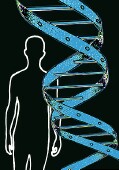
THURSDAY, Dec. 2 (HealthDay News) — An international team of scientists have pinpointed a gene mutation that they believe could be key to so-called “intersex” conditions, in which biologically male or female children develop or display some of the physical characteristics of the opposite sex.
“We have discovered a new molecular switch that seems to modulate the pathways between male and female development,” study author Dr. Harry Ostrer, director of the Human Genetics Program at NYU Langone Medical Center, said in a news release.
Ostrer and colleagues from England, Australia and France report their finding in the Dec. 2 issue of the American Journal of Human Genetics.
This is not the first time a gene abnormality has been cited for its role in conditions linked to sex determination, the authors noted. Among a number of prior discoveries, about 20 years back researchers honed in on a male gene called SRY and linked related mutations to such anomalies.
However, the current focus on various mutations of the so-called MAP3K1 gene revealed that this particular gene may, in fact, act as a controlling on/off switch with respect to SRY activity, either prompting or discouraging an intersex condition.
“MAP3K1 may hold the key to understanding how these various genes are connected,” Ostrer noted.
The authors point out that about one in 1,000 people are affected by intersex conditions, which counters the notion that gender is determined by simple X/Y chromosome patterns.
Normally, male fetuses are distinguished by a pairing of an X chromosome alongside a Y chromosome, while female fetuses are determined by a pairing of two X chromosomes.
Problems occur, however, when a male baby born with an X/Y pairing nonetheless develops some physical attributes of a female child, such as a urethral opening on the underside of the penis or abnormalities such as an underdeveloped or extremely small penis.
Such Y-chromosome intersex children may develop as females but without the ability to menstruate, with partially developed ovaries, an overdeveloped clitoris, excess hair, or ovarian tumors, the research team noted. Infertility can also result.
Ostrer and his associates spent nine years exploring the potential impact of MAP3K1 on intersex conditions by tracking sex determination problems present among two families, one French, the other in New Zealand.
More information
For more on intersex, visit the Intersex Society of North America.

